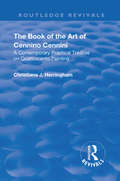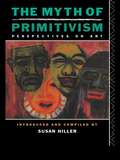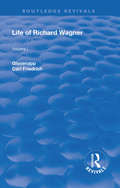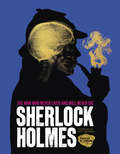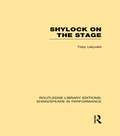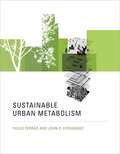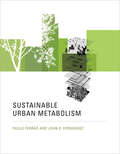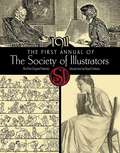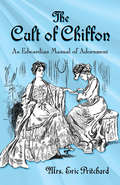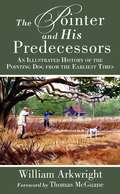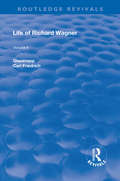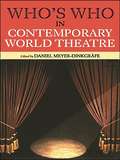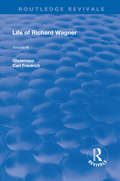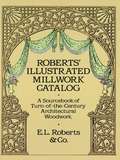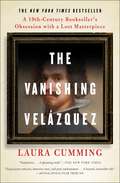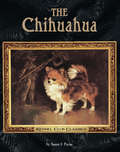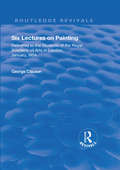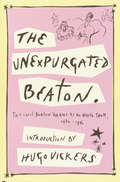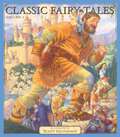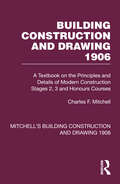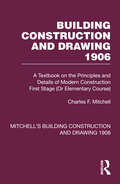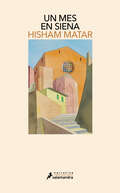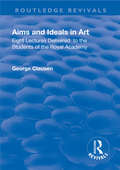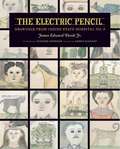- Table View
- List View
The Book of the Art of Cennino Cennini: A contemporary practical treatise on Quattrocento painting (Routledge Revivals)
by Cennino CenniniA Translated version of the Art of Cennino Cennini. A contemporary practical treatise on Quattrocento Painting, including notes on medieval methods, and early explanations of oil painting and other techniques.
The Myth of Primitivism
by Susan HillerThis book explores the fusion of myth, history and geography which leads to ideas of primitivism, and looks at their construction, interpretation and consumption in Western culture. Contextualized by Susan Hiller's introductions to each section, discussions range from the origins of cultural colonialism to eurocentric ideas of primitive societies, including the use of primitive culture in constructing national identities, and the appropriation of primitivist imagery in modernist art. The result is a controversial critique of art theory, practice and politics, and a major enquiry into the history of primitivism and its implications for contemporary culture.
Revival: The Art Work of the Future (Routledge Revivals)
by Carl Friedrich GlasenappThis volume brings our story down to 1843, an important era in Richard Wagner’s Life, with his entry, as composer, of two successful operas, upon a so-called "practical" career at one of the principal German theatres.
Sherlock Holmes: The Man Who Never Lived And Will Never Die
by OtherEver since his creation, Sherlock Holmes has enthralled readers. Our perception of him and his faithful companion, Dr Watson, has been shaped by a long line of film, TV and theatre adaptations. This richly illustrated book, compiled by Alex Werner, Head of History Collections at the Museum of London, is an essential guide to the great fictional detective and his world. Using the museum's unrivalled collections of photographs, paintings and original artefacts, it illuminates the capital city that inspired the Sherlock Holmes stories, in particular its fogs, Hansom cabs, criminal underworld, famous landmarks and streets. Accompanying the landmark exhibition at the Museum of London, the first since 1951, this book explores how Arthur Conan Doyle's creation of Sherlock Holmes has transcended literature and continues to attract audiences to this day. Authoritatively written by leading experts, headed by Sir David Cannadine, this thought-provoking companion sheds new light on the famous sleuth and reveals the truth behind the fiction, over 125 years after the first Sherlock Holmes story was written.
Shylock on the Stage (Routledge Library Editions: Shakespeare in Performance)
by Toby LelyveldOriginally published in 1961, this book is a study of the ways actors since the time of Shakespeare have portrayed the character of Shylock. A pioneering work in the study of performance history as well as in the portrayal of Jews in English literature. Specifically it studies Charles Macklin, Edmund Kean, Edwin Booth, Henry Irving and more recent performers.
Sustainable Urban Metabolism
by Paulo Ferrão John E. FernándezUrbanization and globalization have shaped the last hundred years. These two dominanttrends are mutually reinforcing: globalization links countries through the networked communicationsof urban hubs. The urban population now generates more than eighty percent of global GDP. Citiesaccount for enormous flows of energy and materials -- inflows of goods and services and outflows ofwaste. Thus urban environmental management critically affects global sustainability. In this book,Paulo Ferrão and John Fernndez offer a metabolic perspective on urban sustainability, viewingthe city as a metabolism, in terms of its exchanges of matter and energy. Their book provides aroadmap to the strategies and tools needed for a scientifically based framework for analyzing andpromoting the sustainability of urban systems. Using the concept of urbanmetabolism as a unifying framework, Ferrão and Fernandez describe a systems-oriented approachthat establishes useful linkages among environmental, economic, social, and technical infrastructureissues. These linkages lead to an integrated information-intensive platform that enablesecologically informed urban planning. After establishing the theoretical background and describingthe diversity of contributing disciplines, the authors sample sustainability approaches and tools,offer an extended study of the urban metabolism of Lisbon, and outline the challenges andopportunities in approaching urban sustainability in both developed and developing countries.
Sustainable Urban Metabolism
by Paulo Ferrao John E. FernandezA unified framework for analyzing urban sustainability in terms of cities' inflows and outflows of matter and energy.Urbanization and globalization have shaped the last hundred years. These two dominant trends are mutually reinforcing: globalization links countries through the networked communications of urban hubs. The urban population now generates more than eighty percent of global GDP. Cities account for enormous flows of energy and materials—inflows of goods and services and outflows of waste. Thus urban environmental management critically affects global sustainability. In this book, Paulo Ferrão and John Fernández offer a metabolic perspective on urban sustainability, viewing the city as a metabolism, in terms of its exchanges of matter and energy. Their book provides a roadmap to the strategies and tools needed for a scientifically based framework for analyzing and promoting the sustainability of urban systems. Using the concept of urban metabolism as a unifying framework, Ferrão and Fernandez describe a systems-oriented approach that establishes useful linkages among environmental, economic, social, and technical infrastructure issues. These linkages lead to an integrated information-intensive platform that enables ecologically informed urban planning. After establishing the theoretical background and describing the diversity of contributing disciplines, the authors sample sustainability approaches and tools, offer an extended study of the urban metabolism of Lisbon, and outline the challenges and opportunities in approaching urban sustainability in both developed and developing countries.
The First Annual of the Society of Illustrators, 1911
by Society of Illustrators Royal CortissozA New York City–based institution founded in 1901, the Society of Illustrators remains dedicated to promoting the art of illustration. Ten years after its 1901 founding, the organization resolved to publish an annual compilation of the year's best illustrations by its members. The custom endures to the present day, and the Illustrators Annual remains among the most prestigious publications in its field. This, the first of the organization's annuals, features 85 images by several of the most influential illustrators of the twentieth century, including Frederic Remington, James Montgomery Flagg, Franklin Booth, Charles Dana Gibson, and many others. This new edition reprints the original publication's Introduction by Royal Cortissoz, a highly regarded art critic of the day. Past Society president Dennis Dittrich provides a Foreword, setting the work in context for today's readers and modern-day students of illustration.
The Cult of Chiffon: An Edwardian Manual of Adornment
by Mrs Marian Elizabeth Pritchard Rose Le Quesne"The subject of woman, that is to say, the modern woman, with her varying instincts, pursuits, and peculiarities alone would fill many large volumes. I feel bound, therefore, to confine myself to the discussion of one particular side of her nature, one for which personally I have most sympathy, and one which perhaps can best be described by the epithet 'womanly.'"Originally published in 1902, this extremely rare volume offers a remarkable snapshot of the fashionable Edwardian woman. The author — fashion editor for The Lady's Realm, a monthly London magazine for more "enlightened" readers — offers rich counsel on how to cultivate charm and social standing through the subtle art of dress. Illustrated fashion tips feature a wide range of advice on corsets, petticoats, hats, jewelry, footwear, accessories, and more, with chapters on "The All-Important Question of Colour," "Hats Sublime and Ridiculous," "The Revival of Fashions of the Past," and "The Aggressiveness of the Smart Woman." A selection of vintage advertisements for London-area fashion shops is also included.
The Pointer and His Predecessors: An Illustrated History of the Pointing Dog from the Earliest Times
by William Arkwright Thomas McGuaneOriginally published in 1906, The Pointer and His Predecessors is a highly researched guide to anything and everything relating to the pointing hunting dog. These hunting dogs primarily fall under the setter and pointer breeds, and Arkwright has included everything that an owner would need to know. Anyone who has any interest in shooting and hunting culture will find this book of substantial use.The Pointer and His Predecessors includes topics such as:Characteristics of the PointerBreeding and SelectionShooting Over DogsBreaking and TrainingKennel ManagementAmidst the plethora of factual information are Arkwright’s own theories and anecdotes on the topic of pointing dogs. Arkwright discusses their origin as he pulls biblical quotes and examples to pinpoint where in history these hunting dogs were first spotted. He also recalls on his own experiences with the hounds to exemplify his passion for game dogs. The Pointer and His Predecessors is the top choice for anyone interested in hunting with dogs.Skyhorse Publishing is proud to publish a broad range of books for hunters and firearms enthusiasts. We publish books about shotguns, rifles, handguns, target shooting, gun collecting, self-defense, archery, ammunition, knives, gunsmithing, gun repair, and wilderness survival. We publish books on deer hunting, big game hunting, small game hunting, wing shooting, turkey hunting, deer stands, duck blinds, bowhunting, wing shooting, hunting dogs, and more. While not every title we publish becomes a New York Times bestseller or a national bestseller, we are committed to publishing books on subjects that are sometimes overlooked by other publishers and to authors whose work might not otherwise find a home.
Revival: Opera and Drama (Routledge Revivals)
by Carl Friedrich GlasenappThe second volume of Carl Friedrich Glasenapp's Life of Richard Wagner.
Who's Who in Contemporary World Theatre (Who's Who)
by Daniel Meyer-DinkgräfeWho's Who in Contemporary World Theatre is a lively and accessible biographical guide to the key figures in contemporary drama. All who enjoy the theatre will find their pleasure enhanced and their knowledge extended by this fascinating work of reference. Its distinctive blend of information, analysis and anecdote makes for entertaining and enlightening reading. Hugely influential innovators, household names, and a whole host of less familiar, international figures - all have their lives and careers illuminated by the clear and succinct entries. All professions associated with the theatre are represented here - actors and directors, playwrights and designers. By virtue of the broad range of its coverage, Who's Who in Contemporary World Theatre offers a unique insight into the rich diversity of international drama today.
Printing in Relation to Graphic Art
by George FrenchFrom art in printing to binding, the author explores the printers role in graphic arts. The author answers such questions as: how does one decide which typeface to use? Why do some margins look better than others? What is the purpose of white space? How big should the book be? What is the best way to bind it? What is the best material for the cover? An easy-to-read, interesting, informative book.
Revival: The Theatre (Routledge Revivals)
by Carl Francis GlasenappThird volume of Carl Francis Glasenapp's Life of Richard Wagner.
Roberts' Illustrated Millwork Catalog: A Sourcebook of Turn-of-the-Century Architectural Woodwork (Dover Woodworking)
by Roberts Co.When E. L. Roberts & Co. -- a Chicago-based wholesale manufacturer of architectural woodwork -- issued a catalog of its millwork products in 1903, the firm boasted that the publication included "more novel and useful features ... than any sash and door catalogue yet published," and that it was a book designed to satisfy "critical buyers who demand stylish and tasteful goods."This volume, reproduced directly from a rare turn-of-the-century Roberts catalog, displays a vast assortment of finely crafted products -- from window blinds, brackets, china closets, church fittings, doors, frames, gable finishes, linen closets, moldings, and office furniture to parquet floors, sashes, shingles, side boards, side lights, store fronts, wainscoting, and windows.Nearly 300 sharply defined line drawings and photographs also provide detailed close-ups of exquisitely carved rosettes, head blocks, grilles, arches, and other decorative accents. Included in these illustrations are superb views of late-Victorian interiors finished with ornately carved balusters and newel posts, paneled walls, exquisite filigree, lovely stained glass windows, and magnificent fireplace mantels.Here's a practical source of plans and ideas for architects, students of architectural history, carpentry enthusiasts, preservationists, restorationists, and anyone interested in the interior design and furnishings of a bygone era.
The Vanishing Velázquez: A 19th Century Bookseller's Obsession with a Lost Masterpiece
by Laura CummingFrom one of the world's most expert art critics, the incredible true story--part art history and part mystery--of a Velazquez portrait that went missing and the obsessed nineteenth-century bookseller determined to prove he had found it.When John Snare, a nineteenth-century provincial bookseller, traveled to a liquidation auction, he stumbled on a vivid portrait of King Charles I that defied any explanation. The Charles of the painting was young--too young to be king--and yet also too young to be painted by the Flemish painter to which the work was attributed. Snare had found something incredible--but what? His research brought him to Diego Velazquez, whose long-lost portrait of Prince Charles has eluded art experts for generations. Velazquez (1599-1660) was the official painter of the Madrid court, during the time the Spanish Empire teetered on the edge of collapse. When Prince Charles of England--a man wealthy enough to help turn Spain's fortunes--ventured to the court to propose a marriage with a Spanish princess, he allowed just a few hours to sit for his portrait. Snare believed only Velazquez could have met this challenge. But in making his theory public, Snare was ostracized, victim to aristocrats and critics who accused him of fraud, and forced to choose, like Velazquez himself, between art and family. A thrilling investigation into the complex meaning of authenticity and the unshakable determination that drives both artists and collectors of their work, The Vanishing Velazquez travels from extravagant Spanish courts in the 1700s to the gritty courtrooms and auction houses of nineteenth-century London and New York. But it is above all a tale of mystery and detection, of tragic mishaps and mistaken identities, of class, politics, snobbery, crime, and almost farcical accident. It is a magnificently crafted page-turner, a testimony to how and why great works of art can affect us to the point of obsession.
The Chihuahua
by Susan PayneThird in the Kennel Club Books' Classics series, The Chihuahua recognizes the ever-popular pequeño perrito in one spectacular volume. Written by author, breeder, and handler, Susan Payne, this book's engaging chapters on everything from the breed's accomplishments in performance events, to their participation as service dogs make it much more than just "another breed book." With more than 150 vintage and modern photographs of the breed, this book is a must-have for every Chihuahua owner.
Revival: Delivered to the Students of the Royal Academy of Arts in London, January 1904 (Routledge Revivals)
by George ClausenThe chapters in this volume were delivered at lectures to students of the Royal Academy of Arts in January 1904 by George Clausen, who was at that time Professor of Painting. He approaches the subject a number of ways, including specific masters, styles, methods, techniques, contexts and composition. The book offers a balanced introduction to the subject, and to the modern reader, an insightful glimpse at an approach to this evergreen topic as delivered over 100 years ago.
The Unexpurgated Beaton
by Hugo Vickers Cecil BeatonCecil Beaton was one of the great twentieth-century tastemakers. A photographer, artist, writer and designer for more than fifty years, he was at the center of the worlds of fashion, society, theater and film. The Unexpurgated Beaton brings together for the first time the never-before-published diaries from 1970 to 1980 and, unlike the six slim volumes of diaries published during his lifetime, these have been left uniquely unedited. Hugo Vickers, the executor of Beaton's estate and the author of his acclaimed biography, has added extensive and fascinating notes that are as lively as the diary entries themselves. As one London reviewer wrote, "Vickers' waspish footnotes are the salt on the side of the dish." Beaton treated his other published diaries like his photographs, endlessly retouching them, but, for this volume, Vickers went back to the original manuscripts to find the unedited diaries. Here is the photographer for British and American Vogue, designer of the sets and costumes for the play and film My Fair Lady and the film Gigi, with a cast of characters from many worlds: Bianca Jagger, Greta Garbo, David Hockney, Truman Capote, the Queen Mother and Princess Margaret, Mae West, Elizabeth Taylor, Marlene Dietrich, Rose Kennedy and assorted Rothschilds, Phippses and Wrightsmans; in New York, San Francisco, Palm Beach, Rio and Greece, on the Amalfi coast; at shooting parties in the English countryside, on yachts, at garden parties at Buckingham Palace, at costume balls in Venice, Paris or London. Beaton had started as an outsider and "developed the power to observe, first with his nose pressed up against the glass," and then later from within inner circles. Vickers has said, "his eagle eye missed nothing," and his diaries are intuitive, malicious (he took a "relish in hating certain figures"), praising and awestruck. Truman Capote once said "the camera will never be invented that could capture or encompass all that he actually sees." The Unexpurgated Beaton is a book that is not only a great read and wicked fun but a timeless chronicle of our age.From the Hardcover edition.
Classic Fairy Tales Vol 1
by Scott GustafsonAward-winning artist Scott Gustafson, inspired by the Golden Age of illustration, re-tells and re-imagines some of our best known fairy tales through his inimitable illustrations in Classic Fairy Tales Vol I. The fixed layout ebook format retains the lavishly illustrated spreads from his Classic Fairy Tales printed book (over 190,000 copies sold). These fabulously retold family favorites can be read aloud or enjoyed through the dramatic word-for-word narration by actress Ann Twomey. With over 70 pages of masterful storytelling and magical full color paintings, formatted for ease of use on your e-reader device, this ebook will quickly become a family favorite.
Building Construction and Drawing 1906: A Textbook on the Principles and Details of Modern Construction Stages 2, 3 and Honours Courses (Mitchell's Building Construction and Drawing)
by Charles F. MitchellOriginally published in 1881, but here reissuing the 1906 edition with a new introduction by Stephen J. Scaysbrook, the Mitchell’s Building and Construction Stage 2, 3 and Honours book offers an unparalleled insight into historic construction techniques and materials. Originally written to provide a concise handbook and guide for students and for practitioners, this reissue of Mitchell’s 1906 Advanced and Honours edition now provides a valuable addition to building pathology, allowing students and practitioners to research construction methods and materials pertinent to the period.
Building Construction and Drawing 1906: A Textbook on the Principles and Details of Modern Construction First Stage (Or Elementary Course) (Mitchell's Building Construction and Drawing)
by Charles F. MitchellOriginally published in 1881, but here reissuing the 1906 edition with a new introduction by Stephen J. Scaysbrook, the Mitchell Building and Construction books offer an unparalleled insight into construction techniques and materials. Originally written to provide a concise handbook and guide for students and for practitioners, this reissue of Mitchell’s 1906 First Stage or Elementary Course edition now provides a valuable addition to building pathology, allowing students and practitioners to research construction methods and materials pertinent to the period. Including over 1000 drawings, it is of no surprise to see Mitchell’s First Stage or Elementary edition start with a detailed explanation of the instruments and methods of drawing with pencil ink and tracing paper, emphasising the need to learn basic drawing skills and the need to think about a detail and the materials used to create a detail capable of lasting well over 100 years or more. The simple act of making a scale from a drawing with only one dimension may be lost to modern-day students, but not to Charles Mitchell, who describes the method and its use.
Un mes en Siena
by Hisham MatarUn relato conmovedor sobre la fuerza del arte para sobreponerse al dolor y la desdicha. La pintura de la escuela de Siena se materializa por primera vez en la vida de Hisham Matar cuando el entonces joven estudiante, y futuro autor de El regreso -el poliédrico relato autobiográfico galardonado con el Premio Pulitzer-, se interna en la National Gallery londinense en busca de consuelo tras el secuestro y desaparición de su padre a manos de la policía secreta libia. Frente a ese terrible desgarro familiar, el colorido, la delicadeza de la factura, las curiosas formas geométricas y el impacto dramático de las composiciones de Duccio di Buoninsegna y sus discípulos, que parecen desafiar los límites de la imaginación, dejan a Hisham misteriosamente prendado y suscitan en él un paradójico sentimiento de esperanza en el ser humano. Veinticinco años más tarde, como un creyente devoto que acude al epicentro de su culto, el autor visita por fin la ciudad donde se gestaron esas obras y se sumerge en su contemplación directa, en busca de una verdad que alumbre sus emociones más recónditas. Además de un recorrido esclarecedor por las manifestaciones pictóricas de los maestros sieneses de los siglos XIII, XIV y XV, Un mes en Siena es también un ejercicio profundamente conmovedor sobre la capacidad humana para sobreponerse al dolor y la desdicha. Con una prosa exquisita y medida, bellamente ilustrada y enriquecida con juicios certeros y elegantes, el autor nos invita a reflexionar sobre el valor del arte como instrumento para iluminar nuestro propio paisaje interior y ayudarnos a entender el mundo que nos rodea. La crítica ha dicho:«Todos deberíamos pasar un mes mirando cuadros con Hisham Matar.»Zadie Smith «Una deslumbrante exploración del impacto del arte en la vida y en la escritura, y una lúcida reflexión sobre el duelo.»The Financial Times «Un libro mesurado, frugal y, aun así, absolutamente imponente.»New Statesman «Fascinante, de gran poder evocativo.»The Economist «Un libro de estructura tan exquisita como El regreso, guiado por el deseo, el anhelo y el dolor, iluminado por la amabilidad de los extraños. Un triunfo.»Peter Carey «Una obra delicada y muy bella que cautiva con sus agudas observaciones sobre el arte y la arquitectura, la amistad y la pérdida.»The Guardian «Un texto lleno de pasajes reflexivos, imágenes maravillosas e interesantes observaciones sobre la cotidianidad.»NDR Kultur
Revival: Eight lectures delivered to the students of the Royal Academy (Routledge Revivals)
by George ClausenGeorge Clausen delivers these eight lectures to the students of The Royal Academy of Arts about the aims and ideals of art. He includes the truth to nature and style within art and explores the imagination and taste in drawing and using colour.
The Electric Pencil: Drawings from Inside State Hospital No. 3
by James Edward Deeds Jr.Deeds's subtle, meticulous, and wildly imaginative pencil and crayon drawings portray an unusual cast of characters: nineteenth-century dandies, Civil War soldiers, antique cars, fantastic boats and trains, country landscapes dotted with roaming animals, and fanciful architecture. None of these existed in the actual mid-twentieth-century landscape of Deeds's own life, but rather were representations of his inner world—an artist's poignant tribute to a faded past.
